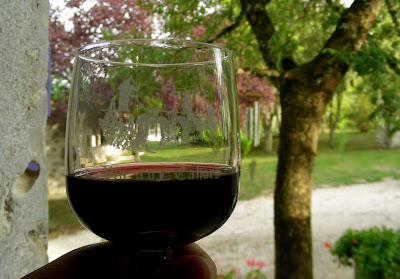France: The Black Wine of Cahors
 The first thing I noticed was the smell; the aroma of Chez Bateau, the pleasant mix of must and wood smoke. It filled my nostrils and bade me welcome as we entered the house.
The first thing I noticed was the smell; the aroma of Chez Bateau, the pleasant mix of must and wood smoke. It filled my nostrils and bade me welcome as we entered the house.We were home. Not our home, of course, but a home we are privileged to call ours for a fortnight.
Outside the door was the oily aroma of herbs from the wild tangle of garden. I remembered this from last time.
I stood by the pool and looked out over the valley and the vineyards and heard the cooing of doves.
This was what I came for.
The air is always fresh here. Today, the day after our arrival, the air is again filled with sunshine and conifers and the faint smell of autumn on the rise.
The leaves are beginning to turn here, but most of the summer flowers are still in full bloom. The hydrangea are stunning, a blend of coral and pale chartreuse; only the roses are fading.
There is a breeze today, and it moans low in the trees and shrubs that dot the meadow running down to the grapevines.
We saw a falcon pirouette against the sky, and in the woods below the vineyards we could hear the frenzied barking of hunting dogs chasing some unfortunate prey.
Yes, this is home. A sensual but spiritual home. Such a vast array of riches to savor.
 Among them are the three bottles of the famous black wine of Cahors that were waiting for us when we arrived. The first thing we did was take the Mini Cooper down to the supermarché for provisions to get us through the weekend. The second thing was to open a bottle and take it out to the pool so we could look out over the vineyards, woods and valley while we savored its rich, dark promise.
Among them are the three bottles of the famous black wine of Cahors that were waiting for us when we arrived. The first thing we did was take the Mini Cooper down to the supermarché for provisions to get us through the weekend. The second thing was to open a bottle and take it out to the pool so we could look out over the vineyards, woods and valley while we savored its rich, dark promise.The wine (which must be 70 percent Malbec grape) is fruity and tannic and - depending on its age - a little bit tart. It has been historically considered easy on the stomach. According to its pedigree, Cahors wine was offered at the wedding of Eleanor of Aquitaine and Henry II of England. Its history is inextricably linked to that of the meandering Lot River. Its vineyards have been wiped out - or nearly wiped out - twice.
It is - like Chez Bateau and the country around it - pure magic.



Comments
Mimi
Welcome back to autumnal Wisconsin.
Flying back from San Francisco last week I thought of you because the pilot flew a very Northern route and we ended up around Lake Superior and then Southbound towards Green Bay and Chicago.
Cahors, one of the oldest French wines, is one of my favorites. Jean XXII who was pope in Avignon in the 14th century until his death in 1334, was born in Cahors and liked that wine so much that he brought some "vignerons" (wine growers) from the Quercy his native province, to improve the planting, harvesting, and vinification methods in nearby Chateauneuf-du-Pape.
Later on, the Orthodox church adopted the Cahors as mass wine.
But in 1956 unfortunately, the quasi totality of the Cahors vineyards were destroyed by a terrible frost.
And it took years for the replanted original local varietals, principally
"l'Auxerrois". also called "Cot", and of corse better known here as "Malbec", to bring allow that beautiful dark-colored wine to regain its quality and prestige.
It is still too underated and little-know here in the United States.
In Chicago, I like to buy the very flavorful " Clos La Coutale" that costs around 14 dolars per bottle.
By the way, as you rightly said in your story, this wine is composed of 70% Malbec but it also get some suppleness and fruity roundness from 20% Merlot and in lesser proportions some typical regional aromas from the "Tannat", a grape that you only find in the Southwest of France.
Cahors, if it is vinified well, can be very pleasant when it is still young, with a nice medium body, good balance of fruit and acidity, and fresh aromas.
But after 2 or 3 years its tannins can become a bit tight and slightly bitter. You have to wait a couple more years to enjoy fully its aromatic qualities of ripe berries and spices. When reaching maturity Cahors is then very rich, round, sexy, and is a perfect companion to roasred duck, wild boar, venison, raw mountain ham, "brouillade d"oeufs aux truffes", and those beautiful mushrooms called "cepes" (or "bolets") that you find in the Valley of the Lot farmer's markets in late summer.
I am confident that you fully benefited from these regional beauties and that you will make us drool with envy when you report about your eating experiences.
Alain (French Virtual Cafe)
Hmmm, Download wine. Roxie, what a great idea! Someday!
Alain, I though of you, too! Funny, I tasted some Cahors for the first time four years ago and it took a while to acquire the taste. I found it a bit vinegar-y. It was maybe 2 years old. The wine we had this time was four years old, and much better. I never fully understood the difference from year to year until August when I visited several wineries in Sonoma County and learned - and tasted - the differences.